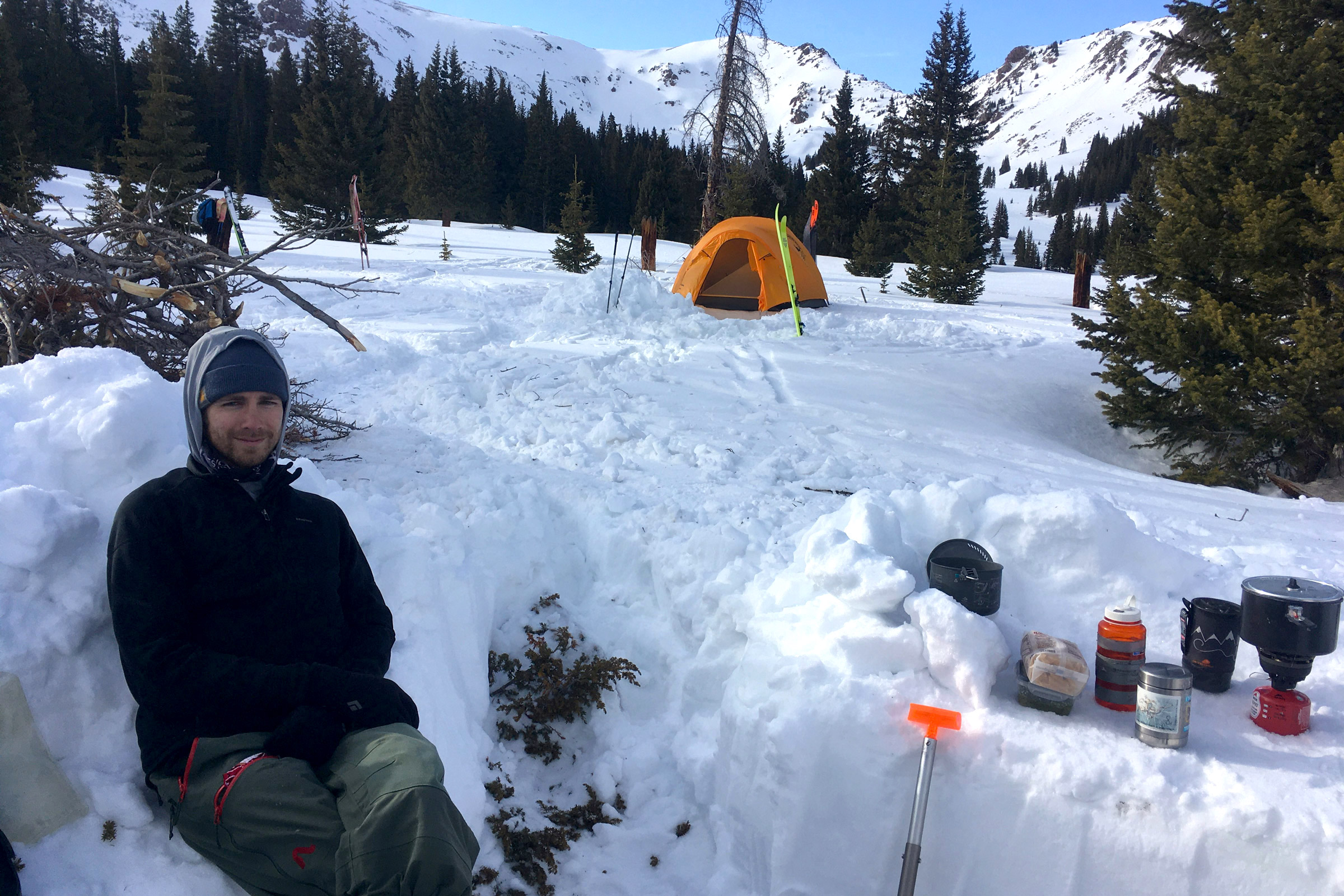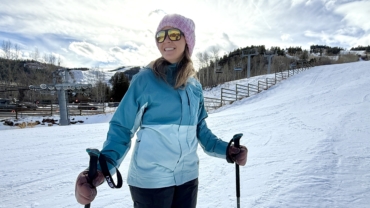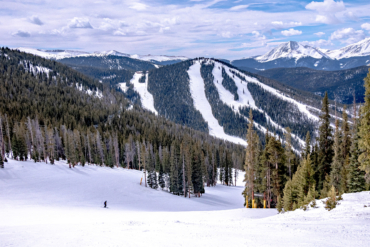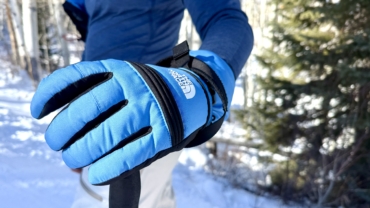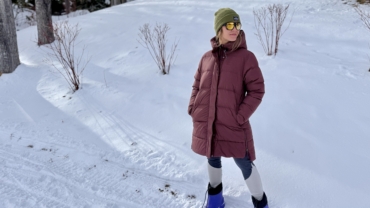I remember the feeling of panic the first time I went winter camping 8 years ago. I was alone in Colorado’s Gore Range. It was 1 a.m., and I was shivering uncontrollably. Everything was wet, I was unprepared, and I didn’t know what I was doing.
I learned quickly that night what not to do. But that trip also opened my eyes to a new world. My favorite terrain, but covered in snow and blanketed in peaceful silence. Not another person for miles. Untracked powder in every direction.
Camping app The Dyrt just reported that nearly a third of campers are now braving the elements to camp during the winter. Winter camping sharply increased by 40% between 2019 and 2021 and has stayed high.
“The fact that the rate of winter camping remains level from the height of the pandemic is remarkable,” CEO of The Dyrt, Kevin Long, said in a press release. “Travelers have every option available to them again, but winter camping remains at an all-time high. People bought the gear, braved the elements, and fell in love with enjoying the great outdoors at a quieter, cozier time of year.”
Backcountry winter camping comes with a learning curve and the gear requirements are specific. It can be intimidating. But the rewards are rich. It’s also a foundational skill for mountaineering and multiday winter traverses. To ease the learning curve, I’ve put together an essential backcountry winter camping gear list and a few hard-won tips to help you thrive whether you’re new to it or a decorated veteran.
Backcountry Winter Camping: Basics & Essentials
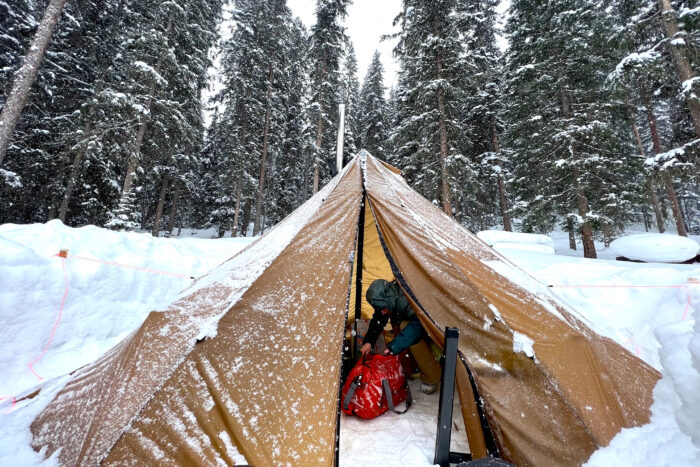
I didn’t start winter camping because I wanted to spend more nights out in the cold. It was really about the untracked powder that sat just outside the immediate radius of winter trailheads. What I quickly learned was how much more there was to love than better access, whether you’re in it for the turns or not.
After a less-than-enjoyable first experience, I’ve spent years learning from the experts and reading every resource available. I now find myself thriving out in the cold darkness.
The keys to success? Staying dry and warm day and night, building a great campsite, and dialing in your camp cooking setup.
Staying Warm During Peak Winter
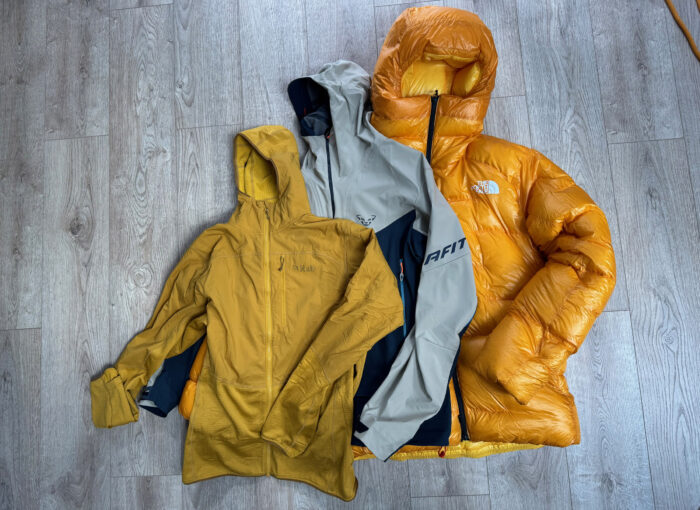
It’s the first question that comes to everyone’s mind. How will I stay warm, and what happens when I get cold?
When you’re hoofing into the backcountry as opposed to driving, dog sledding, or snowmobiling, your pack volume is limited. You can’t bring every last jacket and insulation piece. So having a layering strategy, and system for staying dry, is important.
Wet = Cold
Above all, remember that wet (read: sweat) equals cold. When you’re ski touring or hiking, you’ll get sweaty, and that will cause problems if it’s not addressed.
Once I’m done setting up camp and the aerobic parts of the day are over, it’s time to throw on the cozies and hang dry my wet layers as much as possible, either in the sun or on improvised clotheslines inside the tent.
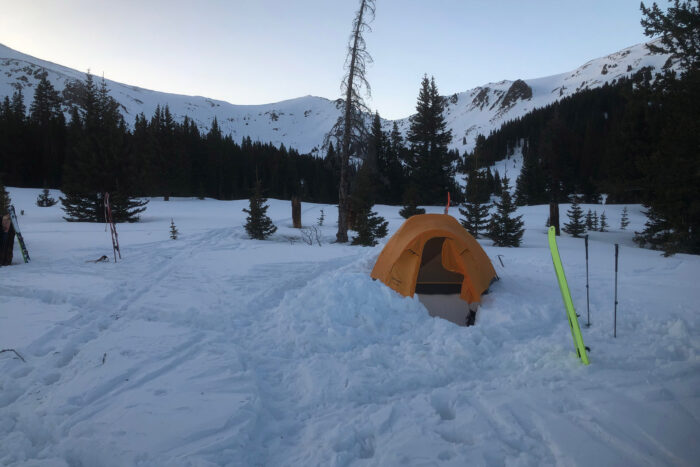
Camp Clothes
When changing out of my active clothes into my camp clothes, I start with a fresh pair of baselayers, top, and bottom, preferably wool. Then come new socks (also wool). It’s at this point that I’ll remove the liners from my ski touring boots and attempt to dry them in the sunlight.
It’s also nice to have camp footwear to switch into when you’ve shed your ski boots. The North Face’s Nuptse Après Booties, Big Agnes Full Moon Booties, or any others from GearJunkie’s guide to the Best Down Booties are ideal.
Layering System
A good layering system traps heat, and blocks cold air and moisture. It starts with baselayers, underwear, and socks. Then you add midlayers for insulation. Typically I use a Polartec grid fleece, a midweight synthetic puffy jacket, and puffy belay pants.
Then, if it’s windy or snowing and I’m outside, I’ll add my hardshell jacket and pants on top.
The last piece I won’t go winter camping in the backcountry without is a big, puffy down jacket. The warmer, the better. Lately, I’ve been leaning on my cocoon-like The North Face Pumori Down Parka for ultimate warmth. GearJunkie’s guide to the Best Winter Jackets also has a lot of other great options.
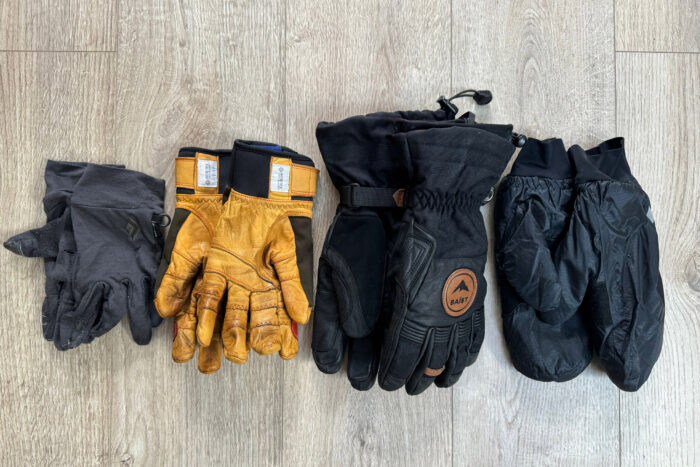
Gloves Galore
Gloves inevitably get wet when you’re touring and digging around in the snow. That’s why it’s important to bring a collection. The backcountry in the wintertime is not the place to skimp on handwear. GearJunkie’s guide to the Best Ski Gloves covers our favorites.
Personally, I always bring a pair or two of lightweight liners. Working/touring gloves like Hestra’s Ergo Active are also extremely useful to have on hand, and a heavyweight waterproof glove like the Baïst Classic Glove is essential. Last, I’ll bring a pair of compressible down mittens.
Sleep Setup
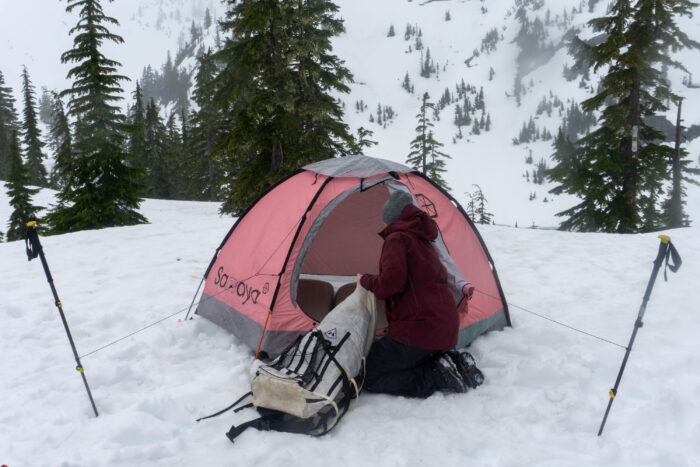
It’s important to have a sleeping bag or system rated for the conditions that you’ll experience. In Colorado’s winter alpine environments, that could be below 0 degrees F. It’s possible to boost the warmth of your bag by adding a liner, which comes in silk, fleece, wool, and down.
The last critical piece? Insulating sleeping pads with an emphasis on insulating. Sleeping pads are rated for warmth with R-values. The higher the R-value, the more insulated the sleeping pad. A classic closed-cell foam Therm-a-Rest Z-rest, with an R-value of 2 is standard for keeping your body insulated from the underlying snow. (It’s also a great seat.)
On top of the closed cell foam pad, a sleeping pad provides the majority of insulation from underlying snow. It is one of the most essential pieces of gear for staying warm at night. Brands like NEMO make winter pads with R-values up to 8. Add an insulated inflatable pad on top for comfort and even more thermal protection from the snow and you’ll rest easy.

I skimped in the sleeping pad department once, and it felt like sleeping (or mostly lying awake) on an ice cube.
I asked IFMG Mountain Guide Mia Tucholke (@mtnmia) what piece of gear she’d never leave behind. She had four recommendations at the ready: hand and toe warmers, extra mittens, and her “sacred socks” — warm socks she uses for sleeping only.
Oh, and two sleeping pads to maximize insulation from the snow.
Pro tip: Still chilly in your sleeping bag? Fill one of your water bottles with boiling water, cover it in a sock, and hug it like a teddy bear in your sleeping bag. It’s a hand warmer for your whole body.
Campsite Selection & Construction
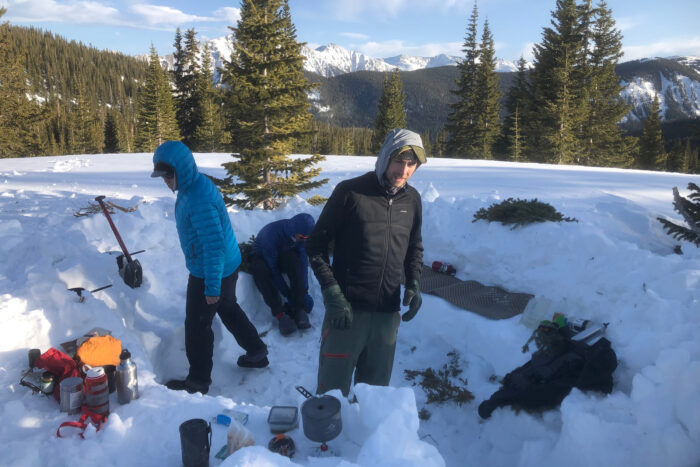
Selecting Your Winter Campsite
There’s a lot to consider when picking a winter camping site in the backcountry. I think of it like a checklist with a couple of “nice to haves” and a few “need to haves.”
Every time, the most critical “need to have” component is to not camp in avalanche terrain or an avalanche runout. Obvious, right? But go ahead and double-check that you’re far enough away anyway. There’s nothing like waking up in the middle of the night worried that you’re too close to that big wind-loaded face.
Generally, shelter from the wind and spindrift is a really “nice to have” component of a camp. Pitching a tent on a windy ridgeline won’t lend itself to a good night’s sleep. Pitching it on the leeward side of a windy slope could bury your tent and all your gear in spindrift overnight in the right (or perhaps, wrong?) conditions.
Read the snow, feel the air, and identify where the wind is blowing hardest and most consistently — and then avoid setting up there.
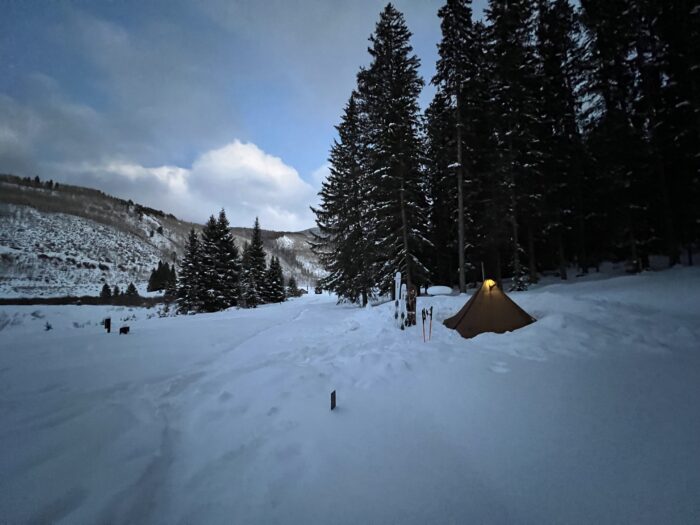
Prepping Your Winter Campsite
When you’re winter camping, you get to build your backcountry campsite from scratch. It’s easily in my top five favorite things about camping in the snow.
Right off the bat, if the snow is fluffy, you’ve got to pack it down so that you can eventually dig it out in blocks. With your skis (or flotation device of choice), walk all over the area of your campsite packing it down, especially where your tent is going to be. Double down on that area, and even a generous radius around it since you’ll need snow to be firm to anchor your tent with guylines.
Let that freshly packed snow harden for 15-30 minutes and avoid disturbing the snow immediately around your tent area without skis on. After waiting, make sure the platform is even and level. If it’s not, add some snow and keep packing until it is.
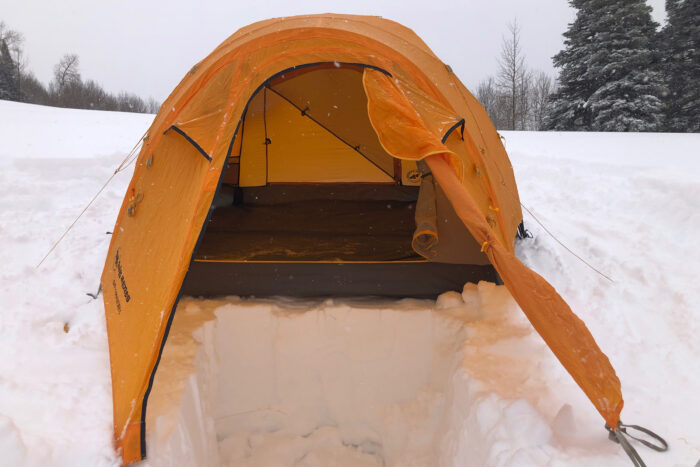
Setting Up the Tent
Once that snow feels packed and hardened, it’s time to set up your shelter. I’ve been in love with my Big Agnes Battle Mountain 3 4-season tent, but the principles are the same for most 4-season tents.
Without disturbing the footprint of the tent with your feet, lay out the footprint or the tent body flat. Next, add the tent’s poles to the corners without clipping the canopy of the tent yet. Grab the most windward corner’s stake loop or guyline. (For more tips, check out GearJunkie’s guide for How to Set Up a Tent in Howling Wind.) You’ll need to “deadman” each guyline and anchor point.

What’s a deadman? It’s a spooky term for the most useful and strongest type of snow anchor. When you can’t stake the ground (because it’s frozen or under too much snow), you use a deadman anchor instead.
They’re easy to make, too. In the most basic sense, a deadman is a perpendicular anchor that gets buried in the snow. When snow gets packed on top and settles, they become really strong.
Almost anything can be used to make a deadman anchor — a tent stake, ice axe, plastic bag or stuff sack filled with snow, a rock, a bundle of sticks, etc. Don’t think too hard about where that name came from.
Now that the tent is at least somewhat attached to the ground, set it up completely, including the rain tarp and vestibules. Now, deadman the rest of the guylines as deep as possible. Once they’re all in there, your tent should be rock solid.
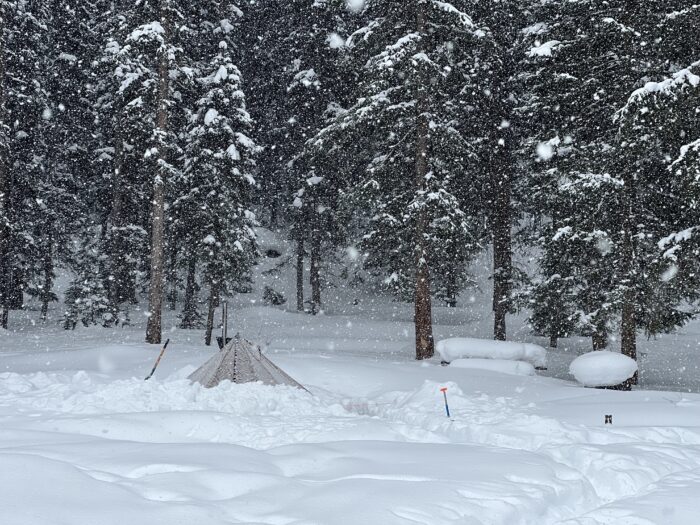
Excavating Your Winter Camp
The last step is digging out the vestibule areas. It’s the best thing about tents on snow. Start with a path from the main campsite area toward the tent. Without disturbing the snow around the vestibule’s anchors, carefully dig out the vestibule area up to the tent body’s main door. I typically go deep enough that I can almost stand in the vestibule and easily sit inside the tent with my legs dangling into the vestibule.
Be careful not to cut under the tent or disturb any of the anchors. Repairing snow certainly isn’t easy.
For extended stays in the backcountry, a dedicated pyramid kitchen/dining/hangout tent, like the Big Agnes Gold Camp UL 5, can be a nice campsite addition, especially if weather conditions deteriorate. Tents like these, when dug out generously, can usually accommodate four to six people sitting upright.
Otherwise, if the weather cooperates, it can be fun to dig out a kitchen/dining pit, with snow benches and shelves for cooking and seating.
Camp Cooking
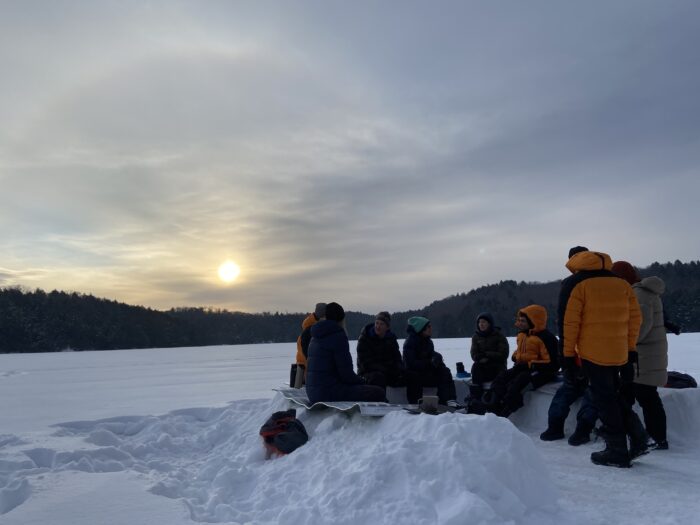
Cooking at winter camp typically isn’t the pleasurable experience that it is in the summer. But eating definitely is! Warm meals go a long way in keeping you warm and your morale high during the long night.
So, I’ll skip the flame, pot, and pan and instead use an ultra-fuel-efficient backpacking stove like the Lite+ from Primus. Stoves like these are fuel efficient and boil water incredibly quickly. Within minutes, I can have a hot ramen appetizer in my hands and a freeze-dried backpacking meal brewing. It’s the best freeze-dried meals will ever taste.
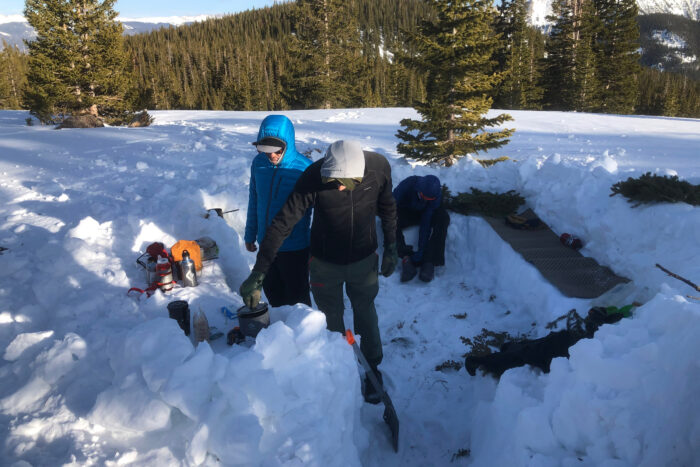
Pro tip: Propane/isobutane fuel canisters do lose some of their vigor in cold temperatures, and they are prone to freezing. It’s important to sleep with your canisters in your sleeping bag at night and keep them warm in your puffy jacket before cooking. It goes a long way in keeping them efficient.
Another option is multi-fuel stoves like Primus’s OmniLight, which can operate at much lower temperatures. This option requires a pot but also expands the volume capacity to melt snow over a canister-style stove.
Be sure to calculate how much fuel you’ll need ahead of the trip. Take into account that melting snow is the only way to get water, too. Nobody regrets bringing a little bit of extra fuel.
The Complete Backcountry Winter Camping Gear List
Below is a complete backcountry winter camping gear list. Everyone’s needs and environments are different, however. Some folks won’t think twice about adding a few more layers. For others, some items might seem like overkill.
Your gear list should evolve with your winter camping experience. Fine-tune it and customize it to your needs. But this is a good list to start with.
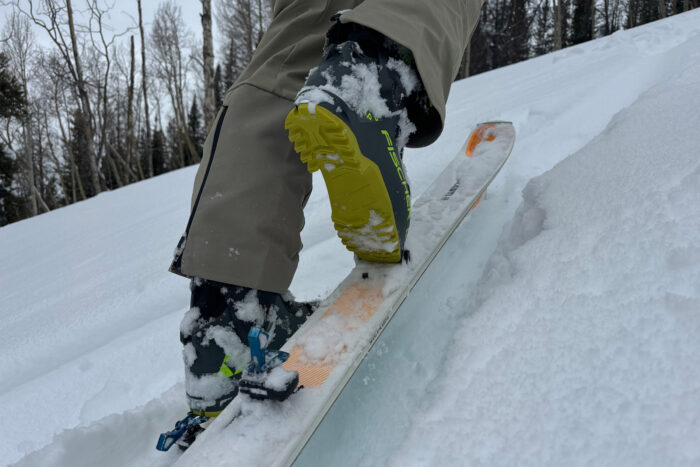
Technical Gear
- Skis, splitboard, or snowshoes
- Ski touring or splitboard boots
- Skins
- Poles with powder baskets
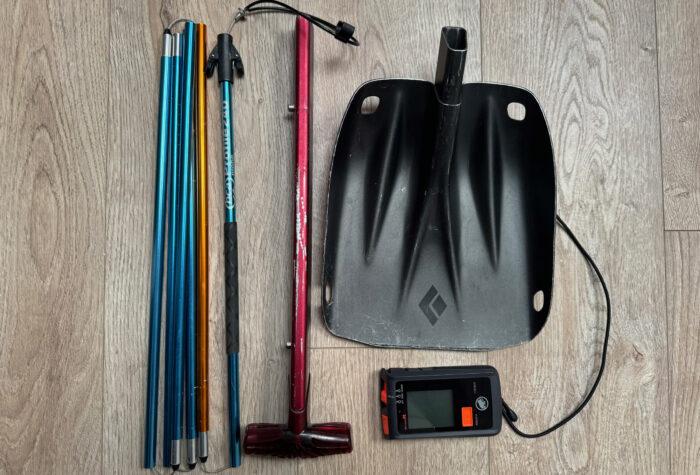
- Packable avalanche shovel
- Avalanche probe
- Avalanche beacon
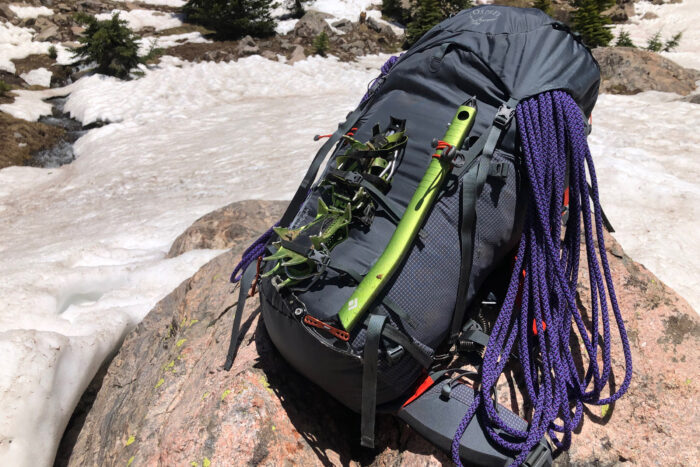
- 50-80L backpack
- Navigation: Electronic and backup paper map
- Compass
- Packable daypack (optional)
- Snow saw for snowpack analysis
- Touring helmet
- Crampons (optional)
- Ice axe (optional)
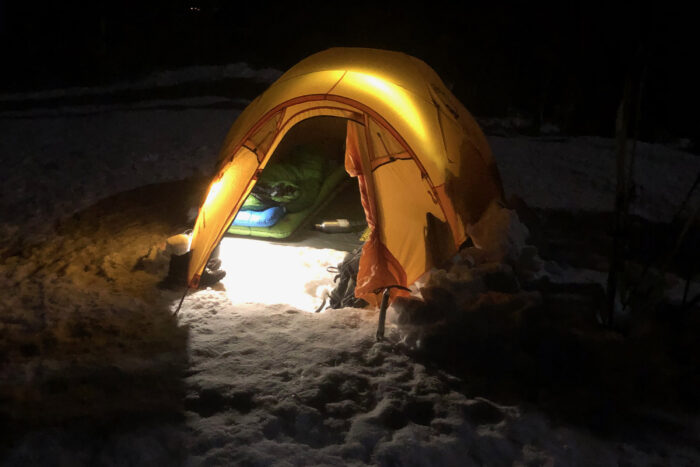
Camp Gear
- 4-Season tent with guylines
- Kitchen/camp shelter like Big Agnes Gold Camp UL 5 (optional)
- Big winter tent stakes for deadman anchors (sticks/rocks also work)
- Sleeping bag or system rated for the temperatures you’ll experience
- Sleeping bag liner for boosting warmth (optional)
- Camp pillow or stuff sack
- Closed-cell foam sleeping pad
- Insulated inflatable sleeping pad
- Headlamp w/extra batteries
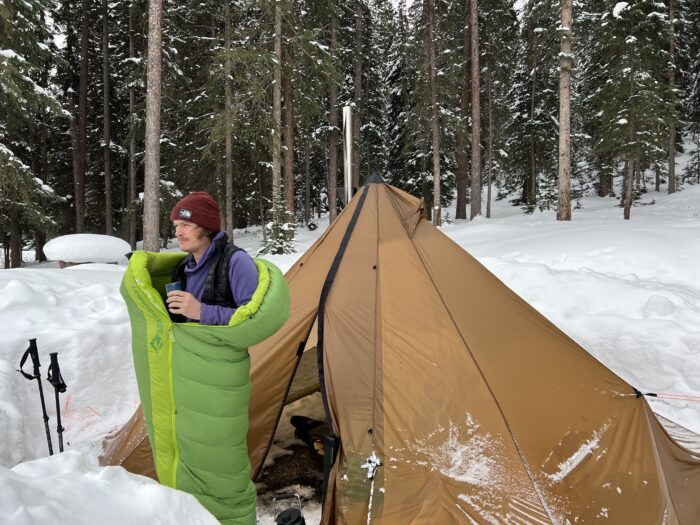
Kitchen Gear
- Backpacking canister stove system or multi-fuel stove
- Fuel and extra fuel
- Cooking pot
- Lighter, matches
- Spoon/fork
- Hand sanitizer
- Ziplock bags for trash
- Insulated mug
- Hot drinks (tea, hot cocoa, apple cider packets)
- Thermos
Clothing & Wearables
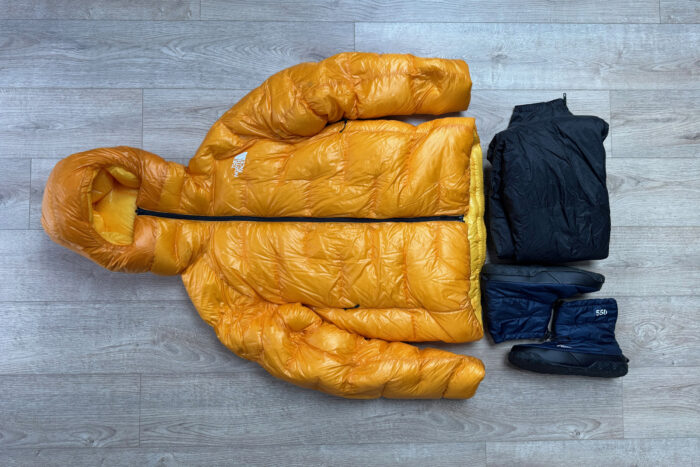
- 2 pairs base layers: one for movement (wet) and one for camp (dry)
- 2-3 pairs of socks: one for movement, one for camp, and/or one for sleeping
- Synthetic midlayer top
- Heavyweight down or synthetic puffy parka
- Down or synthetic insulating pants
- Hardshell jacket
- Softshell or hardshell pants
- Warm hat
- Touring hat
- Protective sunglasses (Ample coverage to protect from reflection off snow)
- Goggles
- Warm gloves
- Working/touring gloves
- Liner gloves
- Down booties or camp slippers
- Boot gaiters (if you’re using snowshoes)
- Neck gaiter or buff
- Sun hoodie (optional)
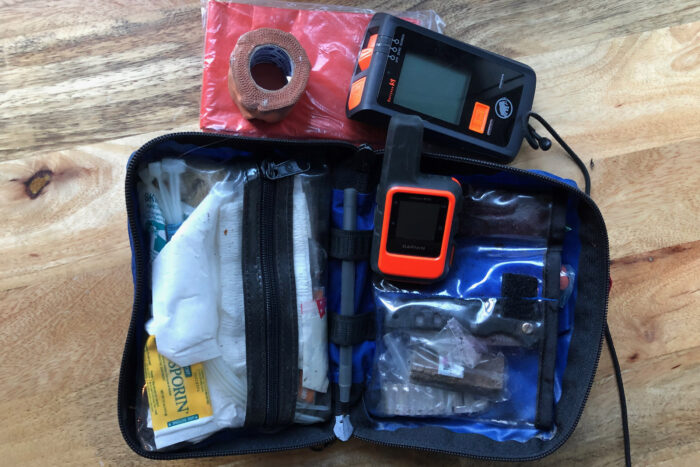
First Aid/Repair
- 3-5 ski straps
- Strong tape
- Multitool with knife and tools for bindings
- Chemical hand warmers for emergencies
- First-aid kit
- Blister tape
- Space blanket
- SOS emergency locator beacon (Garmin inReach Mini or similar)
- Paracord
- Extra pole basket
- Extra tail and tip clip for skins
Personal Gear
- Widemouth water bottle (skip the hydration bladders — the hose will freeze)
- Toiletries
- Sunscreen
- SPF lip balm
- Toe and hand warmers
- Trash bag for lining backpack in bad weather
- Water filter or treatment
- WAG Bag toilet kit
- Smartphone with downloaded maps
- Compact power bank with phone cord
How to Camp in Winter: The Final Word
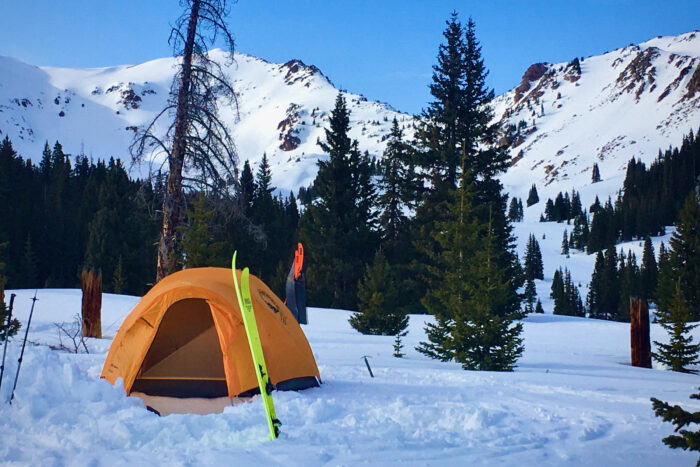
IFMGA Guide Tucholke had another tip for adventures gearing up for their first backcountry winter camping trip — go out in the spring with a favorable weather forecast. And make it a short trip, like one night only. It’s a great way to practice your systems. You don’t have to go on a multiday sufferfest in the dead of winter for your first trip. Or your second, for that matter. Warm up to it.
Like any outdoor experience, there’s a learning curve. But once you’ve mastered the basics of camp design, staying warm, and camp cooking, you’ll have a whole new world to explore where few others venture. The experience of backcountry winter camping is starkly different from camping in any other season.
As Tucholke said to me, “There’s nothing like the peace and solitude of camping in the wild in winter, waking up to the sparkling snow.”
Looking for hands-on instruction before venturing out? Many guide services, like Colorado Mountain School, offer winter expeditions and winter camping courses that can prepare you for winter camping and multiday expeditions.
